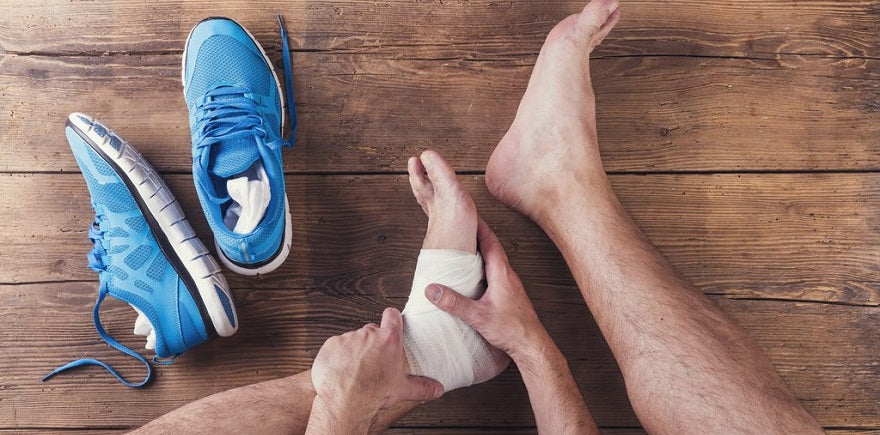
Is Your Foot Pain A Heel Spur Or Plantar Fasciitis?
When you hop out of bed in the morning and feel pain at the bottom of your heel with your first few steps, you want to know what could be causing it. Even if it ends up going away later in the day, it's still bothersome. You might think it's plantar fasciitis based on your symptoms, but not so fast...could it be a heel spur?
The Basics ---
- Heel spurs and plantar fasciitis symptoms are often confused for one another, but actually, heel spurs are not usually a reason for heel pain. Plantar fasciitis is.
- Plantar fasciitis is an inflammation of the plantar fascia, affecting about two million people every year. A heel spur is a type of bone spur, or calcium deposit, that develops on the calcaneus, or heel bone.
- Some risk factors for developing plantar fasciitis and heel spurs include tight calf muscles, weight, flat feet, high arches, abnormal walking patterns, and poor footwear choices.
- Both heel spurs and plantar fasciitis can typically be treated successfully with non-surgical treatments including arch support insoles. We recommend Tread Labs Pace insoles for firm, pain relieving support.
What You Need To Know ---
Heel spurs and plantar fasciitis are two terms frequently used when discussing certain types of heel pain. And while they're actually very different issues, they can be addressed with the same types of treatment.
What's The Difference Between Heel Spurs and Plantar Fasciitis?
There are some misconceptions about how plantar fasciitis and heel spurs are connected. People tend to think that heel spurs are a common cause of heel pain, however that's not the case.
While heel spurs might be associated with pain, they are usually not the reason it occurs, as the Cleveland Clinic points out. Instead, the majority of the time when heel pain strikes, plantar fasciitis is the responsible party.
What is a Heel Spur?
A heel spur, as explained by ScienceDirect, is a type of bone spur, or calcium deposit, that develops toward the back of the calcaneus, or heel bone, where the plantar fascia inserts. These small, jagged bumps of bone usually develop in response to lots of trauma—or damage—to the heel.
This means that in most cases, heel spurs actually form as a result of plantar fasciitis. If the plantar fascia continues to be damaged for a long period of time, the body will eventually create a heel spur to provide additional support for the heel.
Heel spurs are associated with a similar stabbing type of sensation in the heel that is usually worse in the morning and comes and goes throughout the day. But the major difference here is that the heel spur itself is rarely the actual cause of this pain.
In fact, about 10% of the population has heel spurs whether they know it or not, but only 5% of those with spurs will have heel pain. The true reason for pain in most of these individuals, as you might have guessed, is plantar fasciitis.
What is Plantar Fasciitis?
According to Podiatry Today, "plantar fasciitis is at epidemic levels with suggestions that one in six Americans may have the condition." As it has become so common, it's important to understand exactly what plantar fasciitis is.
The plantar fascia is a thick, connective band of soft tissue that stretches from the back of your heel to the base of your toes. As a ligament, it connects the bones in these two areas and it’s designed to be a shock absorber for the high amount of stress you put on your feet.
The plantar fascia is strong and can withstand a great deal of force, but too much pressure can damage or tear it. The body responds to this damage by becoming inflamed, and inflammation of the plantar fascia is called plantar fasciitis.
Plantar fasciitis is usually described as a stabbing pain under the arch and/or on the bottom of the foot near the heel. This pain tends to be worse in the morning and after long periods of standing, exercise, or rest. There may also be some redness and swelling in the area.
Sometimes plantar fasciitis can be confused with Achilles tendinitis. As the American Academy of Orthopedic Surgeons explains, "Achilles tendinitis is a common condition that occurs when the large tendon that runs down the back of your lower leg becomes irritated and inflamed.
The Achilles tendon is the largest and strongest tendon in the body. It attaches the calf muscles to the back of the heel and allows you to stand on your toes when walking, running, or jumping. When you train too hard or intensely without enough rest, Achilles tendinitis can occur, causing pain at the back of the heel or directly above it.
How Heel Spurs And Plantar Fasciitis Are Similar
Here is one of the easiest ways to remember how heel spurs and plantar fasciitis are different. Many people have heel spurs without plantar fasciitis or heel pain, but it’s rare to find someone with plantar fasciitis who does not have a heel spur.
According to one study, approximately 50% of patients with plantar fasciitis also have bone spurs. Since about 1 in 10 people would show a heel spur on an X-ray of their foot, they are only considered an incidental—or insignificant—finding unless there is also foot pain.
When a heel spur forms, it is usually not responsible for causing any foot pain on its own. Instead, the pain is due to the foot condition that caused the spur. So, if you have a heel spur and notice pain at the back of the heel, you probably have Achilles tendinitis.
If the pain is on the bottom of the heel, plantar fasciitis is most likely the reason. Many people have heel spurs without any symptoms at all, and experts are still trying to figure out exactly how spurs relate to heel pain.
Since both plantar fasciitis and heel spurs result from a similar process, the risk factors associated with them are shared in common. The following factors increase the chances of developing both conditions:
- Having tight calf muscles
- Being extremely overweight or obese
- Wearing shoes that are worn out, don’t fit well, or lack proper support
- Having either flat feet, high arches, or an abnormal walking pattern
- Spending too much time on your feet
- Being involved in a sport or activity with lots or running or jumping
- Increasing physical activity levels too rapidly
It’s also important to point out that although the symptoms of plantar fasciitis and a heel spur seem similar, there is one way to help tell them apart. Plantar fasciitis symptoms may be felt in the arch as well as the heel, some patients have it for a while before they notice the stabbing heel pain. In rare cases where heel spurs are responsible, the jabbing pain will be centered in the heel.

How Do You Treat Heel Spurs And Plantar Fasciitis?
If you’re experiencing heel pain, your doctor will examine your foot and may recommend an X-ray to confirm the diagnosis. Although plantar fasciitis is the most common cause of heel pain, it’s important to rule out other causes like Achilles tendinitis, stress fractures, a broken heel, or tarsal tunnel syndrome.
With a diagnosis of either plantar fasciitis or a heel spur, nonsurgical treatments are always recommended first and are usually successful. These include rest and ice, a change in footwear, heel cups, insoles, night splints, physical therapy and cortisone injections:
- Rest, ice, and pain relievers – When heel pain occurs, decrease or stop any activities that might be making the pain worse, and try icing the bottom of your foot with a frozen water bottle for about 20 minutes 3-4 times per day. Pain-relieving medications like ibuprofen or acetaminophen may also help alleviate your pain temporarily.
- Change your footwear – Make sure all of your footwear fits well, is not worn out, and provides sufficient support for your feet, and try to reduce or eliminate your time in high heels.
- Heel cups - These plastic, gel or silicone pieces are inserted into just about any pair of shoes. Heel cups address foot pain by lifting the heel slightly which reduces tension on the Achilles tendon, in turn alleviating pressure on the plantar fascia. They also provide shock absorption for the heel, which reduces stress on the plantar fascia even more.
- Arch support insoles– By providing extra support for your arches, you can reduce the pressure on the plantar fascia. Wearing insoles regularly will help to both relieve heel pain from plantar fasciitis and prevent it from returning.
- Night splints - Designed to treat plantar fasciitis related heel pain throughout the night, these hold the foot and toes back so that the calf muscles, Achilles tendon, and plantar fascia are kept slightly stretched. Available in a boot style cast, sleep supports, and sock style supports, these are a simple and effective way to alleviate morning heel pain.
- Physical therapy – Physical therapy is one of the most commonly used treatments for heel pain. Treatment usually consists of stretching both the calves and plantar fascia thoroughly, as well as manual—or hands-on—techniques performed by the therapist.
- Cortisone injections – If none of these treatments reduce pain levels, your doctor may suggest trying an injection of a steroid hormone called cortisone for additional pain relief.
For people whose pain doesn’t improve after 6-12 months of trying these nonsurgical treatments, surgery is an option.
Healing From Plantar Fasciitis And Heel Spurs
When it comes to heel spur vs plantar fasciitis conditions, it's important to remember that the latter often leads to the former. The good news is that more than 90% of patients with plantar fasciitis will improve in less than 10 months after following these simple nonsurgical treatments.
On the other hand, allowing the pain to persist or trying to push through it will only make matters worse and can lead to bigger foot problems.
With so many different options for treatment, it can be hard to figure out where to start. But, taking charge of your heel pain by finding one that works for you can have you experiencing more mobility and freedom as your heel pain gradually fades away.
Shop Plantar Fasciitis Insoles
Questions? Drop us a line at hello@treadlabs.com. We're here to help.
